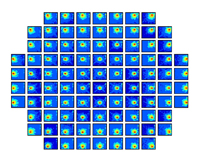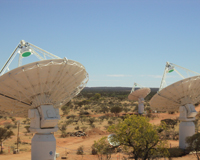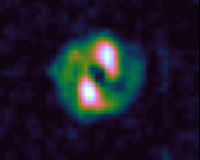Great Progress for ASKAP in 2011
 |
 |
 |
22 December 2011
The past 12 months has seen the construction of CSIRO's Australian SKA Pathfinder (ASKAP) radio telescope and infrastructure at the Murchison Radio-astronomy Observatory (MRO) take great leaps forward.
"2011 was a highly productive year for ASKAP," says Ant Schinckel, CSIRO's ASKAP Project Director.
"Among the brightest highlights of the year have been making another critical step towards the validation of PAFs for radio astronomy and deployment of the first PAFs to the MRO, in the Mid West region of Western Australia."
PAFs, or 'radio cameras', are innovative receivers with many separate, simultaneous beams designed to detect radio waves. They will provide ASKAP with a wide field-of-view, allowing it to map the sky far more quickly than alternative technologies.
In November, the first data from a 188-element PAF on a 12-m antenna at CSIRO's Parkes Testbed Facility was collected using the 64-m Parkes radio telescope as a reference.
"Deep, fast imaging in radio astronomy has never before been possible. The PAF validation at Parkes marked another milestone on the path to proving that PAFs are 'game changing' instruments for radio astronomy," says Ant.
By December, three PAFs had been installed on ASKAP antennas at the MRO. Over coming months the PAFs will be used in single dish and beamformer testing, and progressively, interferometric and phase closure demonstrations of ASKAP at the MRO.
In addition to these significant achievements, CSIRO's ASKAP team has:
- Advanced the construction of ASKAP antennas, with 14 now on site and work continuing towards all 36 in mid-2012
- Become a leading developer of supercomputer software in Australia, utilising the iVEC Pawsey Centre’s new 'epic' supercomputer (a 100 Tflop HP machine) for early ASKAP science imaging tests
- Built infrastructure at the MRO including roads, fibres, power distribution and a world-leading EMC-shielded control building
- Installed 380 km of fibre from the MRO to the coast, enabling SKA-level data transmission
- Completed the process to ensure a strict legislative framework exists for radio spectrum management at the MRO, a site that also has exquisite radio-quietness and a very low population density
- Developed and demonstrated leading edge 'RF-over-fibre' technology to work towards packaging PAFs and their data transmission into a single, integrated, economical package, and
- Assembled and presented an outstanding submission on Australia and New Zealand's case for hosting the SKA.
And these are just a few of the project's highlights for 2011.
"The entire ASKAP team should be immensely proud of this great progress," says Ant.
"I look forward to 2012, when CSIRO will take the next steps in creating this field-changing telescope, ASKAP."
Back to Latest ASKAP News page.
